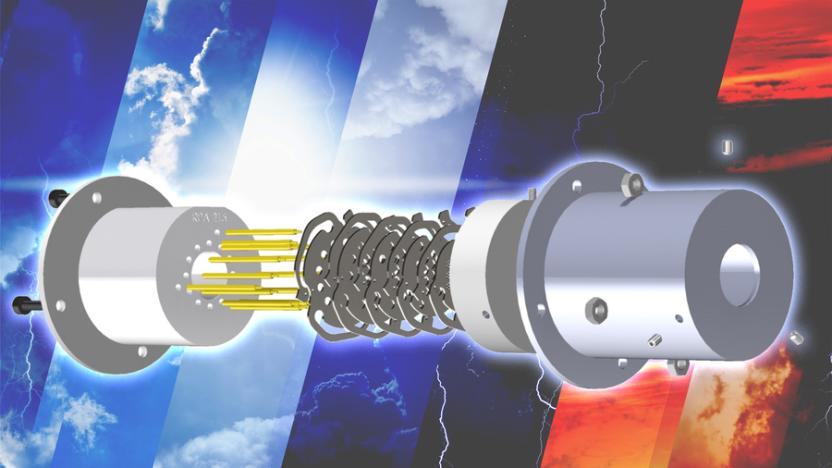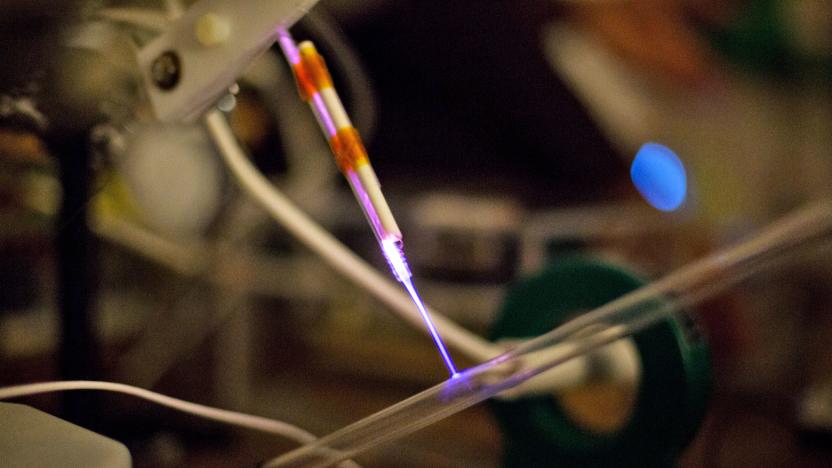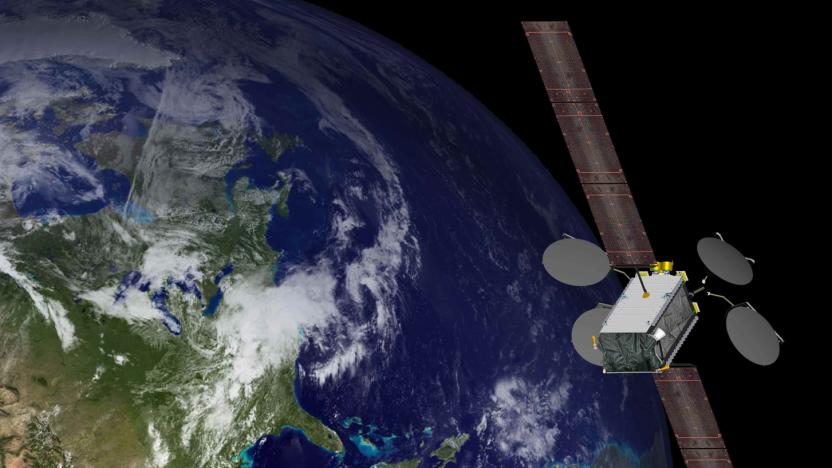plasma
Latest

Researchers created low-cost, 3D-printed plasma sensors for satellites
The sensors could accelerate climate change research.

Portable 'cold plasma' wand prototype could destroy germs in seconds
Engineers from the University of Michigan created a plasma jet wand to disinfect hospital rooms.

Microsoft blood bot helps recovered COVID-19 patients donate plasma
Microsoft’s Plasma Bot is a screening tool meant to help recovered COVID-19 patients donate their plasma to treatment efforts.

Scientists confirm that plasma ‘sloshes’ around in galaxy clusters
For the first time, scientists have observed signs of plasma "flowing, splashing and sloshing" in a galaxy cluster. This kind of motion has been predicted, but it was only theoretical. Now, with data on how the plasma moves, researchers hope to discover how galaxy clusters, the largest systems in the Universe, form, evolve and behave. Their findings have been published in the journal Astronomy & Astrophysics.

A new blood test could indicate multiple conditions with one sample
A new blood test could use a single plasma sample to assess health and predict the likelihood of developing a range of diseases. Thanks to Theranos, this may sound familiar, but unlike that debacle, this proof-of-concept is backed by research published in Nature Medicine.

NASA ramps up its efforts to understand space weather
This week, NASA selected three proposals for missions that could help us better understand the Sun-driven space weather that occurs near Earth. Space weather, like solar flares, can impact spacecraft and astronauts, and it has the potential to disable utility grids on the ground. As NASA prepares to send more astronauts to space and we become increasingly reliant on technology, the need to protect both has become more pressing.

Scientists discover ‘Terminator’ tsunamis on the Sun's surface
Our Sun is quite literally a hotbed of activity. Scientists are learning more about our star's solar cycle, in which its magnetic field flips and its north and south poles swap approximately every 11 years. Little is known about what causes this dramatic shift, although it does seem to be related to sunspot activity. A new set of research papers has laid out more about why solar cycles end and how the cycles can trigger a tsunami of hot plasma to cascade through the Sun's interior.

Shrimp-inspired robot claw could punch through rock
Shrimp may be small, but some of them can pack quite a wallop. One of the pistol shrimp's claws, for instance, delivers such an explosive amount of force that it creates a shockwave of superhot plasma that can take out prey or create impromptu shelters. It only makes sense, then, that scientists hope to harness that power. A team has developed a robot claw that mimics the pistol shrimp's basic behavior to generate plasma and, potentially a valuable tool for underwater science and industry.

Stanford's new lab could make particle accelerators 1,000 times smaller
Particle accelerators have proven vital to understanding subatomic physics, but current technology tends to make them... rather large. And Stanford is determined to address that. SLAC has started assembling a new location, FACET-II (Facility for Advanced Accelerator Experimental Tests), that could lead to accelerators 100 to 1,000 times smaller than you see today. The facility will produce ultra-high quality electron beams that should help develop new, more size- and cost-effective plasma acceleration techniques.

NASA makes contact with satellite lost in space 13 years ago
Proving that things tend to turn up when you least expect them, NASA has just rediscovered a satellite it lost in space more than a decade ago. The Imager for Magnetopause-to-Aurora Global Exploration (IMAGE) was launched in 2000 to create the first comprehensive images of atmospheric plasma. It completed its initial mission in 2002, but failed to make contact again on a routine pass by the Earth in 2005. Scientists hoped an eclipse in 2007 would kickstart a reboot, but when it didn't the mission was declared over, and IMAGE was expected to spend the rest of its days floating peacefully through the universe. Earlier this month, however, an amateur astronomer spotted it in the skies.

Earth's radio signals may be protecting it from space radiation
The Earth's atmosphere bears precious little resemblance to what it looked like at the start of the Industrial Revolution. As radio technology has advanced and spread, the signals that transmitters produce -- specifically the Very Low Frequency (VLF) variety -- have changed the way that the upper atmosphere and the Van Allen Radiation Belts interact, according to a study recently published in the journal Space Science Reviews. In effect, these radio waves may be enveloping the globe like an electromagnetic comforter, protecting it from satellite-frying space radiation.

Fusion reactor endurance record hints at our energy future
Wondering why a fusion reactor isn't powering your home right now? There are numerous reasons, but one of the biggest is simply keeping the necessary super-hot plasma in an ideal state for energy generation -- it doesn't last that way for long. South Korea, however, just edged closer to that goal. The country's KSTAR (Korean Superconducting Tokamak Advanced Research) reactor team claims to have set an endurance record for operating with "high performance" plasma. The feat only lasted for 70 seconds, but that's still a "huge step forward," according to the National Fusion Research Institute.

Watch Pluto's mesmerizing space weather
Ever wondered what the cosmic weather is like, especially around more distant worlds? NASA's happy to help. It recently published a simulation of the Solar System's weather (specifically the Sun's flares, winds and other behaviors) around the time New Horizons swung by Pluto. The color-coded imagery, which reflects the density, pressure and temperature of outgoing plasma, is more than a little hypnotic -- the plasma slowly spirals out, with coronal mass ejections creating shockwaves (the blue you see above) that travel to the farthest reaches of the system.

Scientists built a spacecraft that converts junk to fuel
It turns out that the sky is full of space debris, which poses a threat to craft and satellites orbiting Earth. A team of scientists at Tsinghua University in Beijing, China have come up with a way to remedy this. They've developed a spacecraft that collects the debris in a wide-cast net and uses it as fuel to propel itself forward. This technically means it could keep cleaning forever, unless an unforeseen event brings its efforts to an untimely end. Lasers have been developed for eliminating larger pieces of space junk, however aren't designed for smaller bits that are harder to locate and track. That's where Lei Lan and her team come into the picture.

World's first all-electric propulsion satellite begins operations
Boeing has announced that the first satellite using fully-electric propulsion has begun operating. Dubbed the ABS-3A, this 4,300-pound telecommunications satellite will provide C- and Ku-band service to South America, the Middle East and Africa. Unlike, well most every other satellite in orbit, the ABS-3A doesn't rely on tanks of inert gas for propulsion and orbit maintenance. Instead it relies on the Xenon Ion Propulsion System (XIPS) which employs a magnetic field to push ions around and generate thrust. The satellite is expected to use just 11 pounds of Xenon annually over the course of its 15 year operational life span -- that's a tenth the amount of propellent that a conventional satellite would require.

Floating plasma display makes fairies a reality
See that teensy Tinkerbell-shaped light above? That's not CGI -- that's a real floating display, and it's completely touchable too. Mid-air plasma displays aren't that prolific yet, but they're not exactly new either. However, floating lights created using existing techniques can usually burn skin, since every "voxel" (a pixel in 3D space) is made by heating molecules with nanosecond lasers. In order to make them safe to touch, a team of researchers from the University of Tsukuba, Utsunomiya University, Nagoya Institute of Technology and the University of Tokyo, used lasers that fire bursts of plasma every few femtoseconds instead.

LG nails the coffin down on plasma TVs
It won't be long before you won't need to auction a lung off in order to buy a 4K OLED TV, which means there's even less reason to buy a plasma than ever before. That's why LG has finally joined Samsung and Panasonic in taking the outdated business out back, shotgun in hand. According to Reuters, the company has quietly told local regulators that the plasma TV lines will cease production towards the end of November, leaving China's Changhong Electric Co. as the last manufacturer in town. Still, we'd certainly expect the price of plasmas to slip downward as the technology heads towards the exit door, so perhaps this holiday season is the ideal time to pick up a bargain.

Movie laser guns have nothing on the real thing
Ray guns are high on the list of "physics gone wrong" movie tropes. Unlike the real thing, the blasts are much slower than light, visible in clear air and (depending on who's firing) highly inaccurate. However, laser physicists in Poland have just shown what a powerful laser really looks like. Though no camcorder can follow a light beam, the team used a high-speed camera timed with rapid pulses to simulate a beam traveling through the air. They also added water vapor jets midway to show the plasma ionization (we have no idea what the ghost-like people were doing, though). While the laser fired infrared light, the white beams are actually plasma filaments that formed alongside the pulse. The interaction between the pulse and plasma makes it possible to have a "self-focusing" laser that can be fired far into the atmosphere to detect pollution, for instance. Anyway, you don't need to justify your work to us, Polish scientists -- you had us at "laser videos."

LG is getting out of plasma TVs too, expect an official announcement soon
On the B-side of LG's announcement that it will start selling two 4K OLED TVs, is the bad news for plasma. Korean papers Yonhap News and The Korea Times report home entertainment division lead Ha Hyun-hwoi's comments that the company will end production of plasma TVs soon. According to Ha, LG is conducting an internal study to decide when it will end plasma production -- not a bad run after rumors said it would shut down in 2008 and 2009 -- and will make an official announcement on the issue soon. LG is the last major brand making plasmas after Samsung announced its exit earlier this year, and Yonhap says that once LG shuts down, China's Changhong Electric Co. (the same company once on the receiving end of $1 billion worth of stolen plasma tech from LG) will be the only major manufacturer left in the game. If you don't love LCDs and you're not ready to drop $3,500 on a 55-inch OLED, it may be time to grab one of the few remaining plasmas and ride that out for the next few years.

This is Samsung's last year making plasma TVs
If you've been flirting with buying a new plasma TV, now's the time: Samsung SDI has announced that it's stopping production of PDP (plasma display panels) later this year. The Korean firm's reasons for abandoning the technology echos Panasonic's PDP shut-down -- low demand and declining profits. Of course, the real culprit is likely an increasing focus on 4K, and an inability to manufacture higher-res plasma sets for the mass market. It isn't clear how long the company's remaining plasma sets will remain on the market, but Samsung plans to have the last of its PDP facilities closed by November 30th. Plasma production resources will be repurposed or sold to support Samsung's battery and materials business. This leaves LG as the last major player making PDP-based HDTVs, but if you're a die-hard plasma fan, it might better to hedge your bets and upgrade sooner rather than later. [Image credit: Tomas Hudcovic/isifa/Getty Images]











